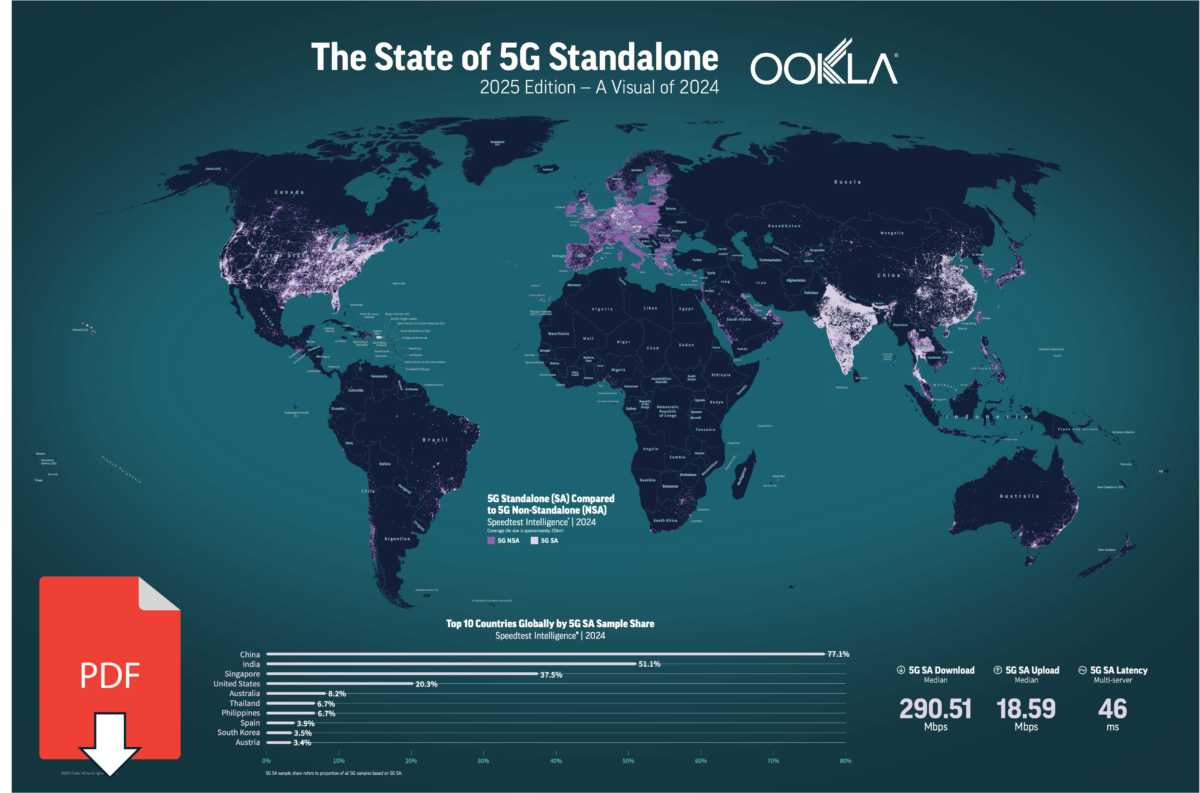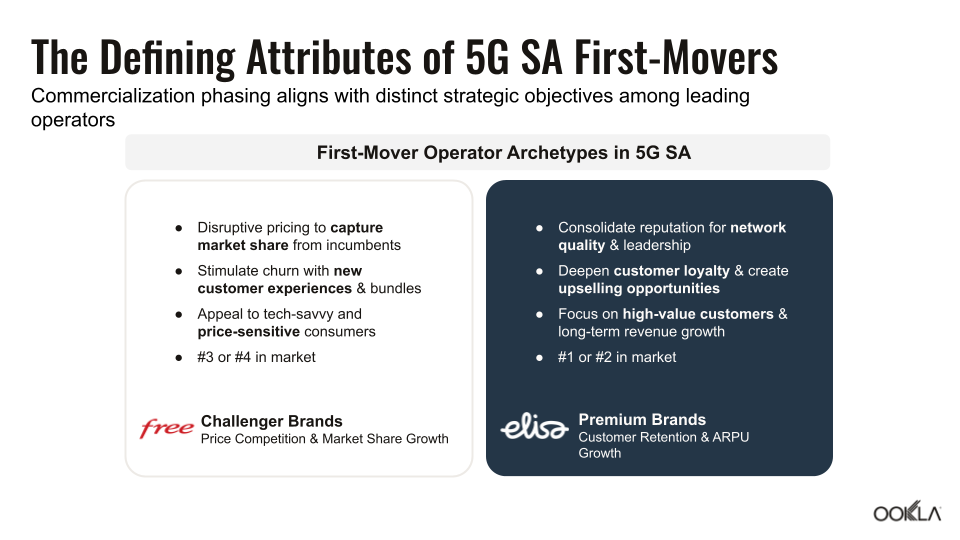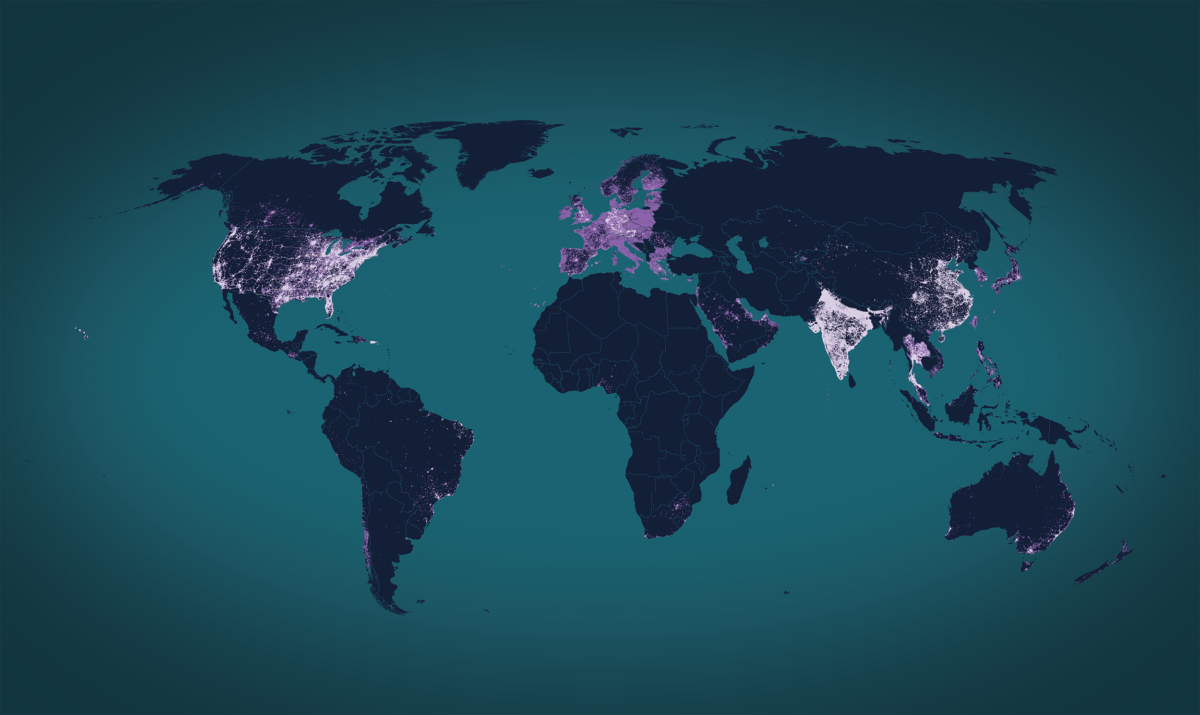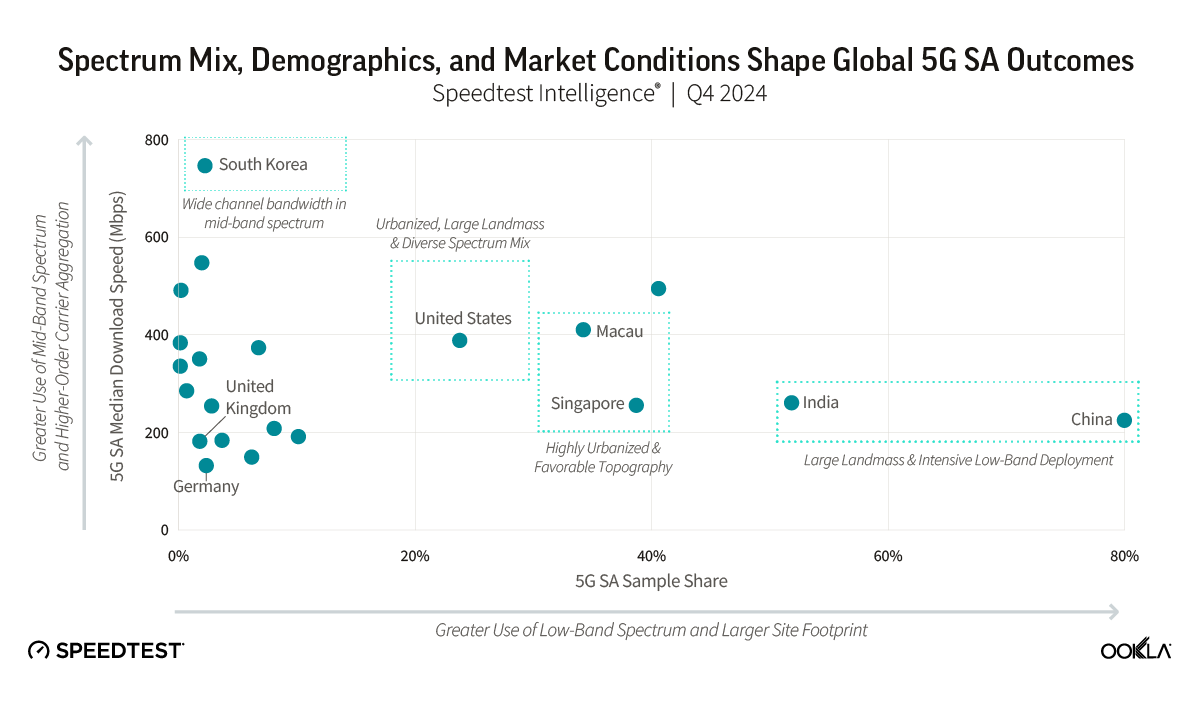As 5G networks continue to mature globally, the industry is witnessing a pivotal shift toward 5G Standalone (5G SA) architecture, which offers significant performance improvements compared to the initial Non-Standalone (NSA) 5G deployments that began in 2019. This evolution to 5G SA represents not just a technical upgrade but a fundamental reimagining of what mobile networks can deliver to both consumers and enterprises.
The global 5G SA landscape shows significant regional variations in deployment strategies, performance metrics, and monetization approaches. Using network data from Speedtest Intelligence® and market analysis from Omdia, this article looks at the current state of 5G SA development across different regions and the innovative ways operators are working to monetize these investments.
For a deeper dive into these topics, including expert analysis and interactive data visualizations, watch our recent webinar featuring Ookla and Omdia analysts. Additionally, our collaborative study with Omdia – “Global Evaluation of Europe’s Digital Competitors in 5G Standalone” – provides comprehensive analysis of 5G SA networks, their performance benchmarks, and the business considerations telecom operators face.
Global 5G SA Deployment Status
Understanding where different regions stand in their 5G journey is crucial for operators planning their network evolution and investment strategies with 5G SA. The global landscape of 5G SA deployment shows striking variations that reflect different market priorities, regulatory environments, and competitive dynamics.
Our analysis shows that China, India, and the U.S. have established clear leadership in 5G SA deployment, with China showing over 80% 5G SA sample share in Ookla’s network measurement data. Meanwhile, Europe lags significantly behind, despite the European Commission setting some of the most ambitious 5G infrastructure targets of any advanced liberal economy.

These regional disparities highlight the different approaches operators are taking, with some focusing on early competitive launches (to maintain network leadership and cater to the premium market segment), while others are being more cautious and balancing deployment against investment constraints. Several key trends are shaping the global 5G SA landscape:
- Regional momentum: Despite a slow start, the EMEA region has accelerated its deployment pace, accounting for 70-75% of commercial SA launches in the last two years, with Spain and Austria emerging as regional leaders.
- Performance gains: 5G SA is delivering consistent improvements across markets, particularly in reducing latency and providing faster median download speeds, with the U.S. emerging as a global performance leader through T-Mobile’s multi-band spectrum strategy.
- Regulatory impact: Government funding programs and regulatory requirements have proven effective in driving deployment, with countries like Spain (Unico funding program), the U.K. (merger-related coverage obligations), and Germany (spectrum auction conditions) showing stronger progress.
The data clearly shows that no one-size-fits-all approach works for 5G SA deployment, with operators in each market pursuing strategies that reflect their specific circumstances. Countries implementing targeted regulatory measures and spectrum strategies are showing stronger progress, suggesting that supportive policy frameworks play a significant role in accelerating deployment.
Consumer 5G Monetization Strategies
Many operators have struggled to increase average revenue per user (ARPU) despite significant 5G investments over the last several years. With 5G Standalone technology, operators now have new opportunities to create premium offerings that customers truly value, moving beyond simply selling larger data packages.
The most successful operators are finding ways to turn technical capabilities like faster speeds, lower latency, and guaranteed service levels into premium services that target specific customer groups. A recent Omdia survey of 19,000 consumers showed people are willing to pay more for specific benefits like faster speeds, priority video streaming, location-based speed boosts, reduced gaming lag, and better performance for work applications. These consumer preferences are already translating into real-world offerings, with several innovative approaches emerging across markets:
- Speed tiers: Elisa in Finland offers SA-enabled “5G Plus Premium” with an 18% price premium over standard 5G service
- Performance guarantees: Three Austria provides bandwidth guarantees for 5G home internet, with premium tiers commanding a 23% price premium
- Event-based services: Singtel offers special “Event Pass” options for sporting events and concerts, giving customers priority connections when networks are congested
- Gaming packages: Deutsche Telekom’s 5G Plus Gaming service combines reduced lag times with a bundle of over 100 games for €10
- Priority connections: U.K. operators target premium subscribers with “Network Boost” and “5G Ultra” services that provide prioritized connections in crowded areas
These early examples demonstrate a clear shift toward more targeted service offerings. Operators are finding that different customer segments have different priorities and different willingness to pay for enhanced services, and the most successful approaches recognize these differences rather than treating all customers the same. While premium operators pursue advanced technical capabilities and guarantees, value-focused providers can still compete effectively with simpler offerings at competitive price points.

Fixed Wireless Access (FWA) Opportunities
5G Standalone technology is helping operators deliver competitive home internet service through Fixed Wireless Access (FWA), creating new revenue streams beyond mobile subscriptions. The approach varies by market, but the enhanced capabilities of SA networks — particularly through network slicing (creating dedicated virtual sections of the network for different services) — allow operators to deliver reliable home broadband while ensuring mobile customers maintain a good experience.
Effective FWA strategies depend heavily on local market conditions. Some operators use FWA to compete with traditional broadband providers, while others focus on underserved areas where fiber deployment is impractical. Key FWA deployment patterns include:
- Dedicated capacity management: Operators like Elisa use network slicing to separate FWA traffic from mobile traffic, protecting their valuable smartphone customers while delivering better home internet performance
- Market-specific strategies: U.S. operators have enough spectrum to deploy FWA widely without needing to separate traffic, while European operators in markets with extensive fiber networks must be more selective about where they offer FWA service
- Targeted customer segments: FWA appeals to specific customer groups like students and temporary residents who value flexibility, while also serving as an alternative in areas underserved by traditional broadband
- Competitive positioning: Mobile-only operators use FWA as an entry point into the home to compete with traditional broadband providers
FWA represents a significant opportunity for operators leveraging 5G SA capabilities. Our webinar highlighted how FWA approaches vary significantly by market, with operators adapting their strategies based on spectrum resources, existing broadband infrastructure, and competitive dynamics. These tailored approaches allow operators to target specific customer segments and market gaps where FWA offers the most compelling advantages.
Conclusion
The transition to 5G SA represents both a technical evolution and a business opportunity, but success requires understanding what consumers actually value. Beyond raw speed, consumers care about a consistent quality of experience, and the good news is that 5G SA is already delivering tangible improvements in network performance and the user experience.
Operators deploying 5G SA are recognizing that different customer segments have distinct priorities. By creating tailored offerings that address these needs — whether for entertainment, productivity, or other use cases — they are turning 5G SA’s technical advantages into services consumers are willing to pay more for.

For deeper insights into global 5G SA deployment, performance metrics, and monetization approaches, watch our webinar and check out our comprehensive report “Global Evaluation of Europe’s Digital Competitors in 5G Standalone.”
Ookla retains ownership of this article including all of the intellectual property rights, data, content graphs and analysis. This article may not be quoted, reproduced, distributed or published for any commercial purpose without prior consent. Members of the press and others using the findings in this article for non-commercial purposes are welcome to publicly share and link to report information with attribution to Ookla.




